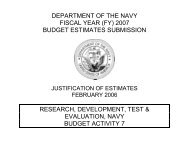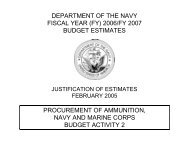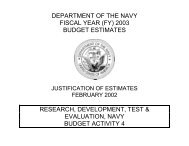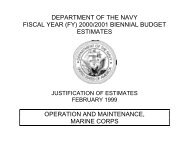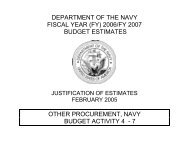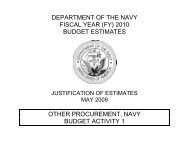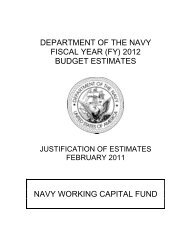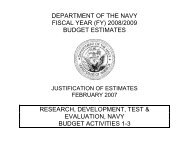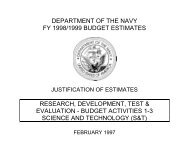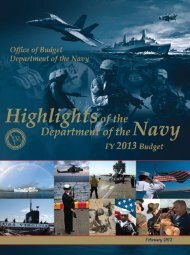Budget Highlights Book - DON FM&C Website - U.S. Navy
Budget Highlights Book - DON FM&C Website - U.S. Navy
Budget Highlights Book - DON FM&C Website - U.S. Navy
Create successful ePaper yourself
Turn your PDF publications into a flip-book with our unique Google optimized e-Paper software.
February 2010Rebalancing Investment to Meet Global RequirementsThe AGM‐114 Hellfire is a family of laser guided missiles employed against pointand moving targets by both rotary and fixed wing aircraft. The variants includeshaped charge warheads for use against armored targets and blast fragmentationwarheads for use against urban structures. The AGM‐114N is a thermobaric blastfragmentation warhead that maintains the capability provided by the AGM‐114Mwhile adding a unique capability against confined compartmented spaces, a typicaltarget type observed in current combat operations. The versatility of the Hellfiremissile helps make it the ʺweapon of choiceʺ in overseas contingency operations.Because of the AH‐1/H‐60 armed helicopter requirements, this weapon is essential toSea Shield and Sea Strike.Ground WeaponsGround‐based, indirect fires are a key component of the reach and lethality of theMAGTF. The Marine Corps’ fire support triad includes three systems supported byfunding in the FY 2011 budget. The first element, the Light Weight 155mmHowitzer, is 40% lighter than the aging and less mobile M198 Howitzer allowing forgreater tactical mobility and range, with improved weapon stability, accuracy, anddurability. FY 2011 includes an update to the digital fire control system. The secondelement, the High Mobility Artillery Rocket System (HIMARS) vehicle and launcher,combined with the Guided Multiple Launch Rocket System (GMLRS) providesaccurate and rapid precision fires in general support of maneuver forces at rangesexceeding 60 km. Rocket munition hardware is funded in FY 2011. TheExpeditionary Fire Support System (EFSS) is the third and final element in the landbasedfire support triad with 10 systems procured in FY 2011. Internallytransportable via the MV‐22 and CH‐53E, the EFSS will be the primary indirect firecapability to the vertical assault element of the STOM force, providingunprecedented flexibility in direct support of indirect fires.MINE WARFAREMines remain a significant asymmetrical threat presenting anti‐access challengesthat can disrupt our ability to execute our mission. Sea mines can prevent access tonaval and commercial vessels, negate our maritime capability advantages anddisrupt or slow operations in the littorals. The FY 2011 Mine CountermeasureMaster Plan ensures that sufficient quantities of mission packages will be procuredto successfully prosecute major combat operations. Research and developmentefforts remain on track to deliver the mine countermeasures capability to Littoral5–20 FY 2011 Department of the <strong>Navy</strong> <strong>Budget</strong>



